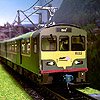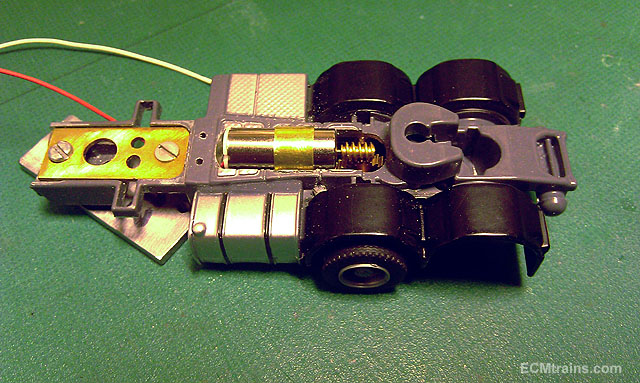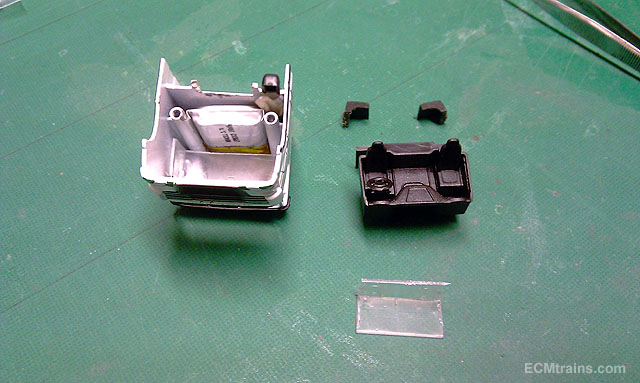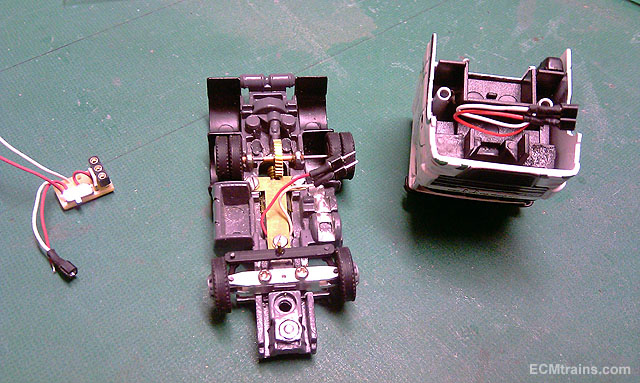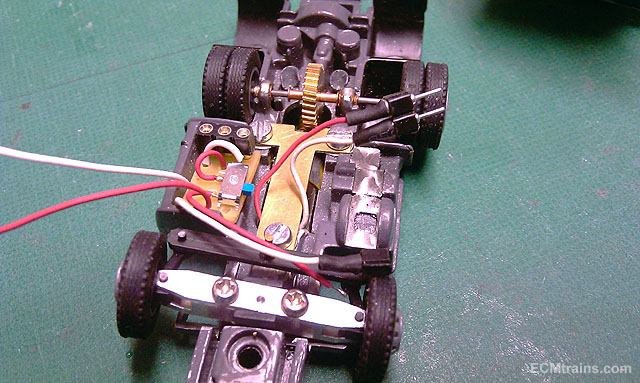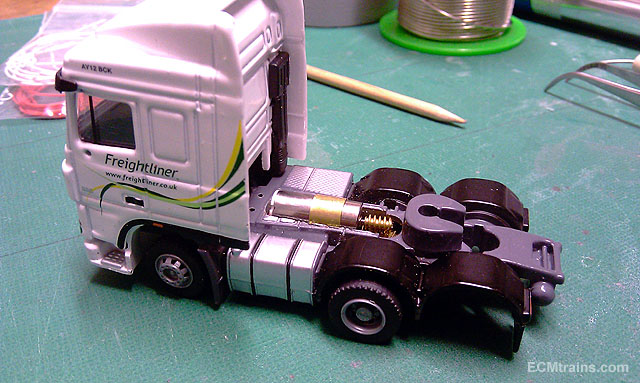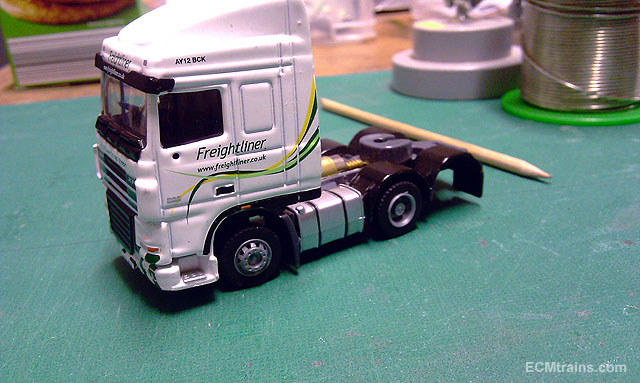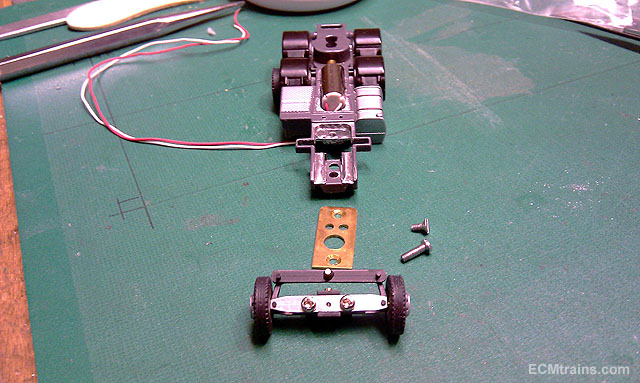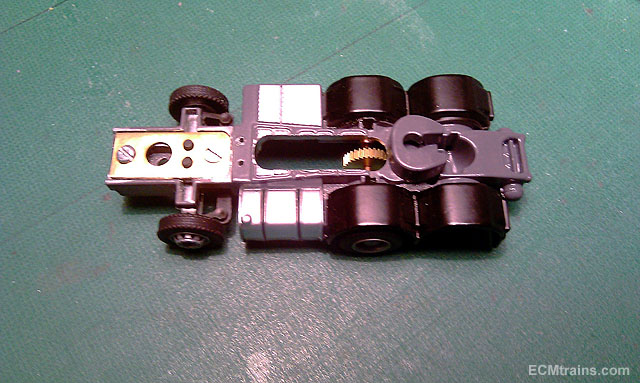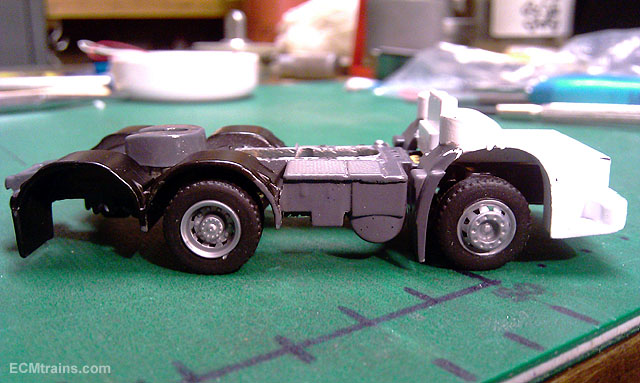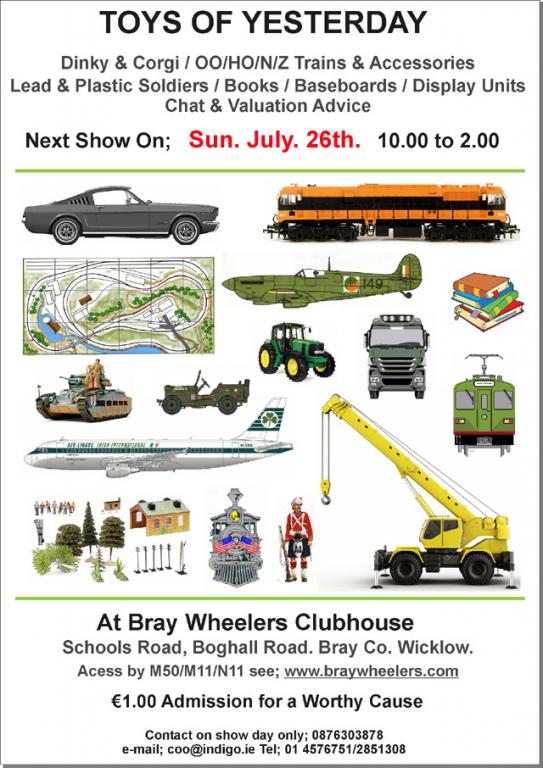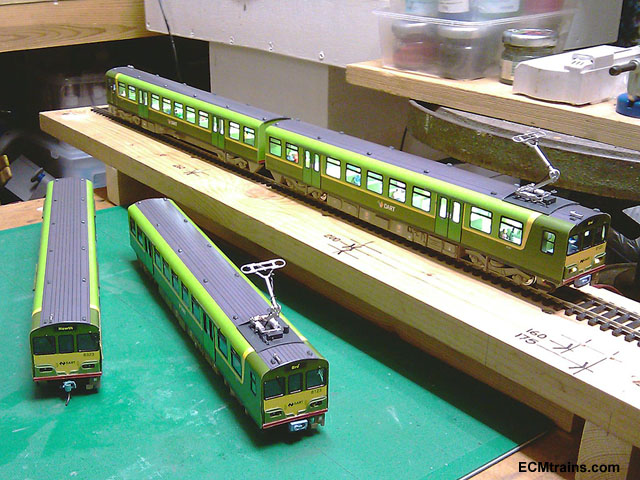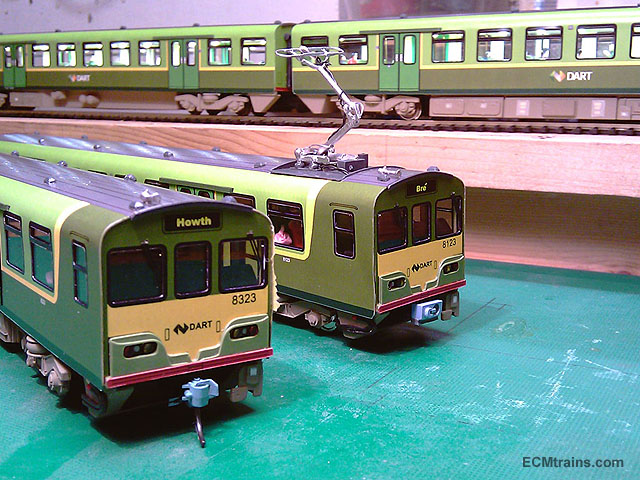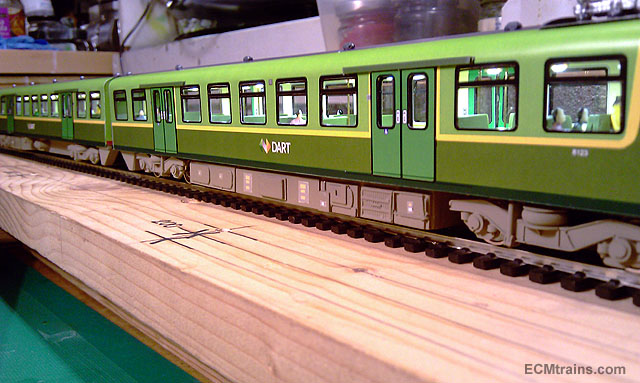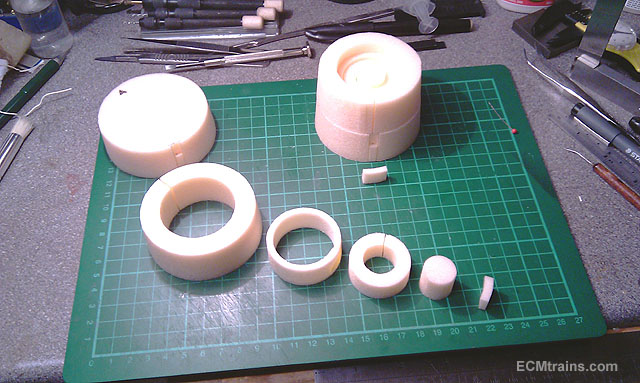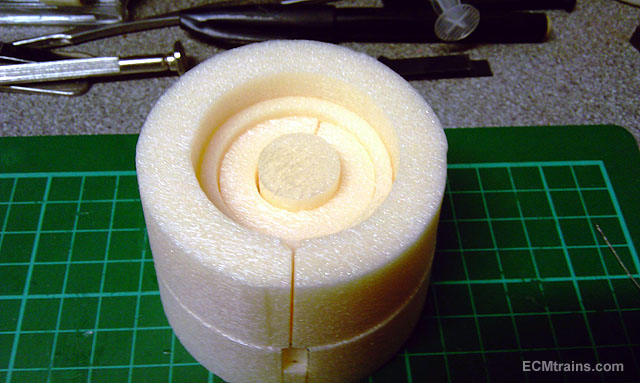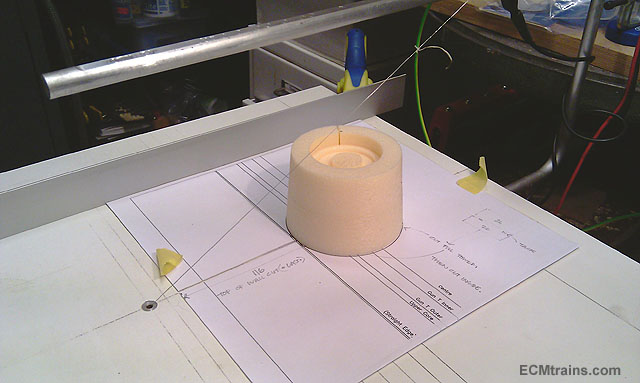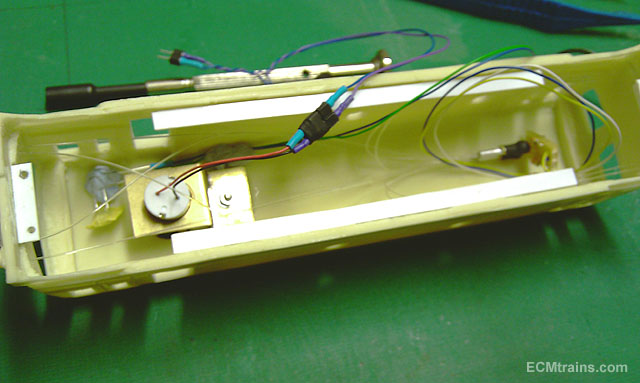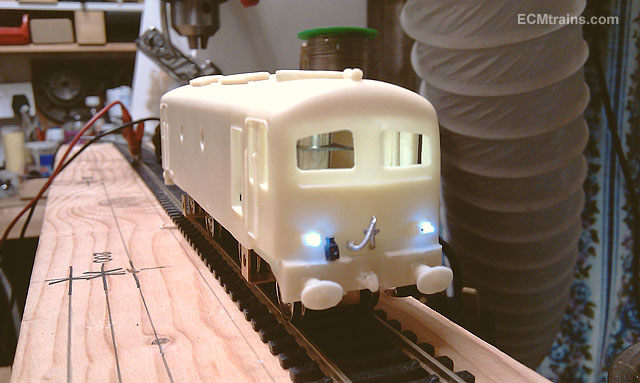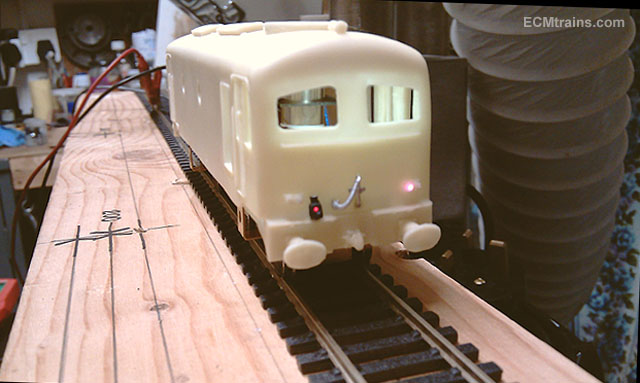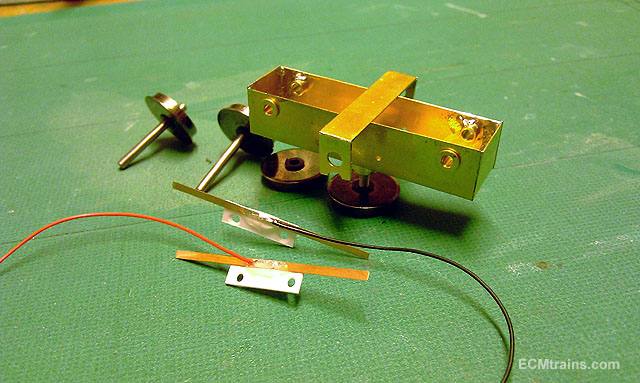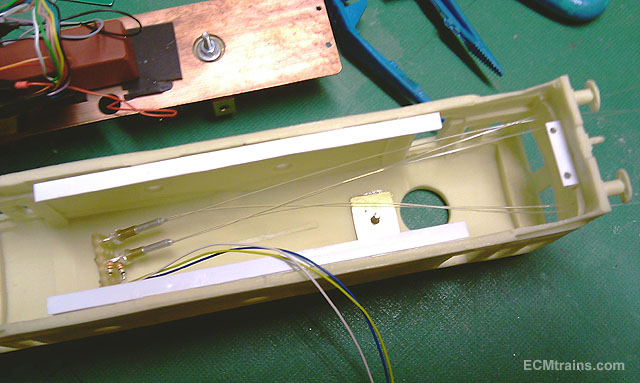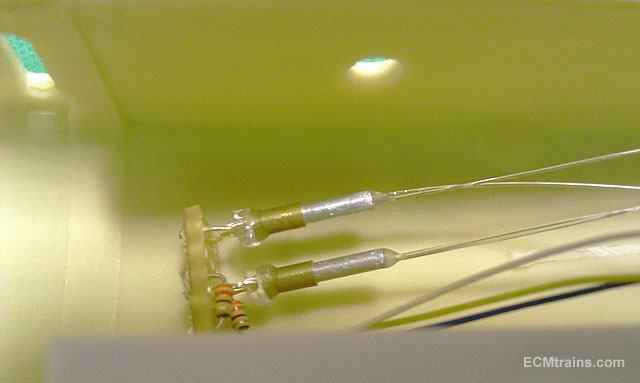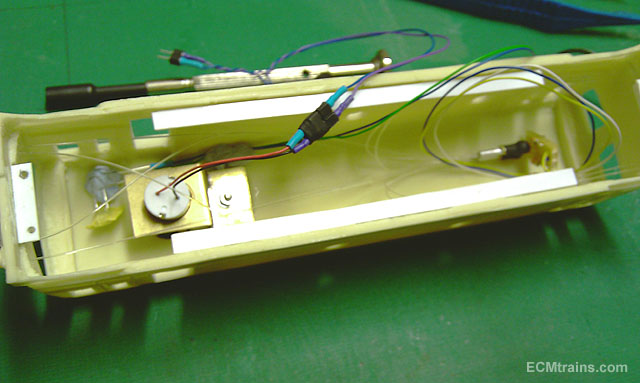-
Posts
2,730 -
Joined
-
Last visited
-
Days Won
70
Content Type
Profiles
Forums
Events
Gallery
Blogs
Store
Community Map
Everything posted by murrayec
-
Hi I got a bit more done on the Daf conversion;- Motor mount made from .23mm brass sheet Mounting fits nicely into the chassis, attached with screws Now to fit the LiPo battery into the cab behind the seats Back-end of the glazing and plastic behind the seats is removed, and two lugs in the die-cast ground away and the battery fits snugly Battery in and leads extended, electrics board has started but I broke the reed switch so cannot complete it until I get a new one The board sits into the petrol tank The motor doesn't look to bad, and with the trailer on it will almost disappear- some paint will help! Eoin
-
Hi David Excellent stuff, OO or O gauge the technique is the same. I plan to do the same thing on the Greystones Station Building..... What glue do you use on the VIVAK plastic? I use this material but have not found a solvent glue for it, the manufacture recommends a solvent but does not name a product, nor answers emails regarding. Love the building structures to, givenme loads of ideas Eoin
-
Hi Those were the days when you could drive a motorbike anywhere That point under the old tunnel in the photo above was one of my favourite fishing grounds many years ago, we would camp in the tunnel and hang out fishing for a few days, some amazing Bass fishing there if you got the time right.... also its my favourite walk with great scenes all around including trains One of the members on the forum may be doing a diorama of this area in the near future! Eoin
-
Hi controller If you are using DCC, one should run the lights from the decoder so that you have on/off control of the lights! This would involve wired couplers- two wires, to run down the train to power the lights, then no pick-ups are required on the coaches. DCC Supplies & Gaugemaster are 2 suppliers of electrical couplers. The resistor for the LEDs all depends on what type of LEDs your using- single?, strip of LEDs?, or other.... Capacitor & rectifier- I don't know much about in these circumstances;- I know the cap has to be huge if you want to smooth out electrical pick-up! I would recommend sticking with the DCC system, to me it's simpler and you have control Eoin
-
Hi I'm converting an Oxford Daf 105 Skeletal Trailer Freightliner to the Faller System and here's my take on it, with help from friends and the internet. After getting the Faller Truck conversion kit and sizing things up it was decided to make some replacement parts for the front axle as the Faller system is for HO- 6mm scale difference in width! Also the Oxford Daf weighs far more than the plastic HO Faller trucks and the plastic axle beam would take on a droop over time. In the photos part of the Faller beam is shown in front of the new fabricated axle beam to give an idea of the scale difference. There is a 2.5mm diameter difference between Faller and Oxford wheels so it was decided to use Faller throughout. Also, install the load carrying axles in roller bearings to reduce friction and help with the weight (not in the kit) including the trailer, the drive axle is mounted in copper bush bearings supplied with the conversion kit. The side photo shows the scale of the wheels, and without the Oxford wheels in the view- sure it's grand! Lumps of metal were removed from the chassis, cut-outs were made for the steering through the sides, the reed switch (the brakes), and the horizontally mounted 3V motor and drive gear. A brass plate was made to support the front axle and to hold the front of the chassis in place;- the Oxford chassis has free air where the axle beam needs to mount! ... So far so good;- Motor goes in next -that needs to be worked out!, and some mods need to be done to the cab for the battery, then a bit of wiring and.......... Eoin
-
Wow Thanks all for the great comments, it's great to share these experiences and get feedback, thanks I took a better video of the 6'er DART the next day, I'll post it up when I get a chance to edit it. It's at times like this I wish I had a fully landscaped up layout to run trains on for taking video.... Eoin
-
Hi I got to set up a 6 coach DART this evening for a little drive, I took some video, but as it was late in the day the light was not great- so here is a short video of a 6 coach Sunday Evening DART heading back to Dublin by way of the test track! I think I'll redo this when there is better light Eoin
-
Hi Check this out;- https://www.google.ie/search?q=full+size+lego+house&tbm=isch&tbo=u&source=univ&sa=X&ei=Eq2eVcPON4i17gbXjYWwBg&ved=0CCAQsAQ&biw=1280&bih=891 Eoin OOPS!!!!
-
Hi Check this out;- https://www.google.ie/search?q=full+size+lego+house&tbm=isch&tbo=u&source=univ&sa=X&ei=Eq2eVcPON4i17gbXjYWwBg&ved=0CCAQsAQ&biw=1280&bih=891 As far as I know, Lego was invented by an Architect, for use in modelling architectural proposals! Eoin
-
Hi Tony Yes, I'm enjoying this to... Recently when playing Lego with my 5 year old nephew I decided to go freestyle- well that was it, the walls came tumbling down, he ran off in disgust and complained to his mummy ''he's broken it, he's not using the instructions'' I still have some Lego- though I use it for making mould casings! Eoin
-
Hi Nelson That's a fantastic job, I love your photo setting, that window frame has to be from the era your modelling! Eoin
-
Hi Broithe Sad, poor guy.... Sepoint to Williams Town tracks and the waterfront there has been a very popular area for the life ending business, I know three people, or knew, that exited there. Many years ago myself and friends were involved in a situation like Joe's, on the Seapoint Bridge- I did notice the guy responded better to the girls in the discussion, he eventually gave up on the idea to jump... another poor guy Eoin
-
Hi DC Yes it blows a little, I only put a slight twist on the blades, I may twist it a little more next time around... Eoin
-
Hi Thanks guys for the great comments Riversuir226;- I have added you to the list, keep an eye on this thread for when its available, I only hit this project in spots here and there- but I am getting there!... Warbonnet;- Yes, this can be arranged, but I recommend at least 10 units to start with and see how you go from there! Eoin
-
Hi DC Don't know about the Abbeyleix show- where's Broithe? But the Chris Dyer Fairs show is on Sept 13 in the Stillorgan Park Hotel, South Dublin. Eoin
-
Here it is;- This is a clip of a 12v electric fan test on the Class C locomotive, the motor is running from the loco DCC chip on a function button with a few resistors to bring down the speed, when complete it will have its own DCC chip which will control speed and direction. Eoin
-
untilhttp://irishrailwaymodeller.com/showthread.php/94-Toys-of-Yesterday-Bray-Show?p=72826&viewfull=1#post72826
-
Hi All Here are a few shots of the first two '2014 logo livery' DARTs out of the workshop last week;- Eoin
-
Hi Here are a few photos of the set-up for an N Gauge Martello Tower cut out with the hot wire cutter;- This shot shows the exploded components for one tower and a second assembled. The tower is done in two sheets so that the door recess can be cut in the lower section. This shot shows the components just about to be glued together This shot shows the tower set up on the machine ready to slide in under the wire and cut the top parapet chamfer. The tower is held to the cardboard template by a drawing pin so the tower can be rotated under the wire when in position. The cardboard with tower is slid in under the hot wire up to the mark, taped down, and then the tower is carefully rotated This shot shows the parapet cut Eoin
-
Hi Chevron If your still watching I have posted some photos and text on my Class C ECMchas thread here;- http://irishrailwaymodeller.com/showthread.php/4121-Class-C-ECMCHAS-For-Silver-Fox-Kit?p=72820&viewfull=1#post72820 Eoin
-
Hi All I have now constructed a non motor bogie to run some tests- see below;- There is some making in this and after it all I have found its cheaper to use the second motor and have that extra umph! I tested the new bogie and could only pull 5 coaches max and at this the throttle had to be full open to get moving. Pulling small wagons- it's grand, up to 10 can be run without difficulty. So the two motors are more economical and more powerful - decision made. Here are a few photos of the lighting system going in, the directionals are run by two clear LEDs with .45mm fibre optic strands doing the bulb job on the loco. The LEDs are shrouded with a brass tube, with an aluminium tube socket holding the FB strands. The strands are epoxied in and the ends polished for best pick-up. This is the brass shrouds over the LEDs with the FB strands plugged in This is a shot of the system complete, some shrinkie was added over the LEDs as they were lighting up the inside. Also the radiator cooling fan has been installed and cab light blue tacked in to test. Under test in forward direction with cab light on Under test in reverse direction I used the Tiger lamp fibre optic strands on this build, they are ok but varies in size from strand to strand- .4mm up to5.2mm. Also there were a number of small fractures in the strands which looses some light, but the clear LEDs are quite powerful so no major loss. The red lamps are done by a touch of paint on the end. Eoin
-
Hi Forget those pancake motors, I reckon its the gear drive system that causes all the problems. By the time you've messed about with it, you would have fitted a replacement Tenshodo spud or a Black Beetle into that hole with a little brass bridge support fixed to the chassis. Eoin
-
Hi Looking at this CLIP system, I may be wrong, but it looks like sharp corners are going to be a problem. Any of the examples shown have this feature! Eoin
-
Sorry GSR800;- Do not use a drill bit on your brand new Alan Gibson links, no matter how careful one is the drill bit will not go in centred and will mess up the links with loads of slop. There is a tool for this work called a 'Broach' - sets can be got from Expo Tools also looking at the model I think the screws are pretty big and the Gibson links may not allow for that size hole! a remedy for this is to solder on large washers centred over the rod holes and then open up the holes to size. Eoin
.png.c363cdf5c3fb7955cd92a55eb6dbbae0.png)

